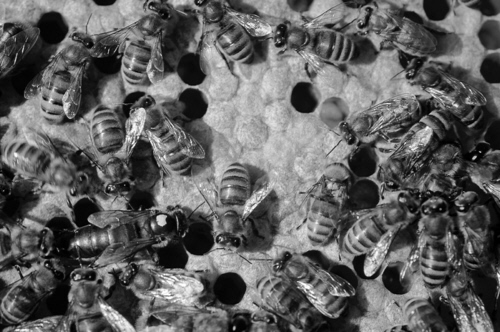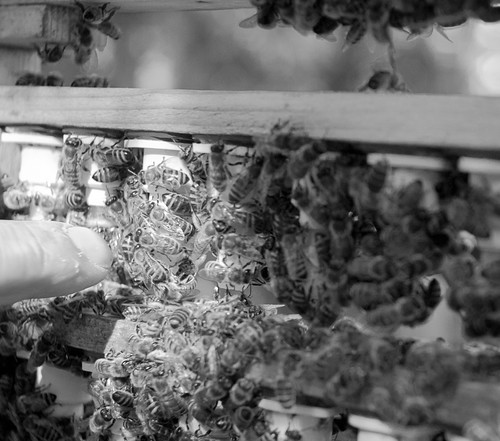I went recently to the local farmers’ market in order to buy products directly from the producers where I met Jan-Thore Riseng, a beekeeper who lives a short distance from me. Having presented the purpose of slow pix, he willingly accepted to show me his bee hives and how he’s working with honey bees. Jan-Thore lives in the countryside in Sande south of Drammen, and having arrived at his place, we went to a set of bee hives close to his house. Wearing a jacket with an integrated hood and net to cover the face, he opened his bee hives and inspected them one by one. First, he took off the lid, then he applied a dash of smoke to the honey bees, which he called knocking on the door, but which is used to calm the bees. Using a tool, he gently lifted the vertical frames in the hive, most of them full of bees. Having a trained gaze, he could immediately recognise the health of the bees, their gender and so on, while I just saw lots of insects crowded together. In fact, beekeeping is a huge subject and all beekeepers need to cooperate with others, learn from experts, and so on. Jan-Thore started beekeeping in 2002 when he was taught by an elderly beekeeper how to do this interesting and useful activity.
Like all domestic animals, pedigree is extremely important in beekeeping and honey bees are bred in order to obtain the following characteristics:
- Gentleness
- Good brood pattern (the honey bees have to take good care of their young)
- Rapid spring build up (the honey bees should start producing honey when spring arrives)
- Resistance toward pests and disease
- Minimal swarming (the bees shall not escape from the hive in order to make a new colony)
- Good honey production
The honey bees in the hive are mostly females, who are workers, while the males have only one task: mate with the queen. Jan-Thore showed me some of his queens, being more than twice the size of the workers, and having a bright spot on their heads. The spots were colour-coded such that he could know how old they are at a glance. Since the queens only live 3-4 years, he’s breeding new ones and even has some for sale.
Looking at the frames, the were almost covered by bees, but the honeycomb base, a plate made of wax in order to give the bees a foundation on which they can build the honeycomb was easily visible. Parts of the honeycomb base were covered with honeycomb, a mass of hexagonal cells built by the honey bees. Some of the cells were covered completely, while other ones were open and it was possible to see tiny larvae inside. Some honey bees had moved head first into the cells, probably to feed the larvae. The colour of the honeycomb varied from yellow to brown and Jan-Thore said it was caused by different types of pollen collected by the honey bees. The pollen is used as food for the larvae, while the nectar is transformed to honey and used as food by the bees.
Jan-Thore keeps his honey bees near fields in the county of Vestfold where he lives, renting out his hives to local farmers. In autumn, he brings his hives to Nissedal in the county of Telemark in order to let the honey bees pollinate heather and create heather honey, a delicacy in Norway.
Only a few of us can be beekeepers, but there are many cooperatives who let everyone adopt a bee hive for a small charge. Here is one example where you pay 150 NOK a year. Other possibilities certainly exist.


